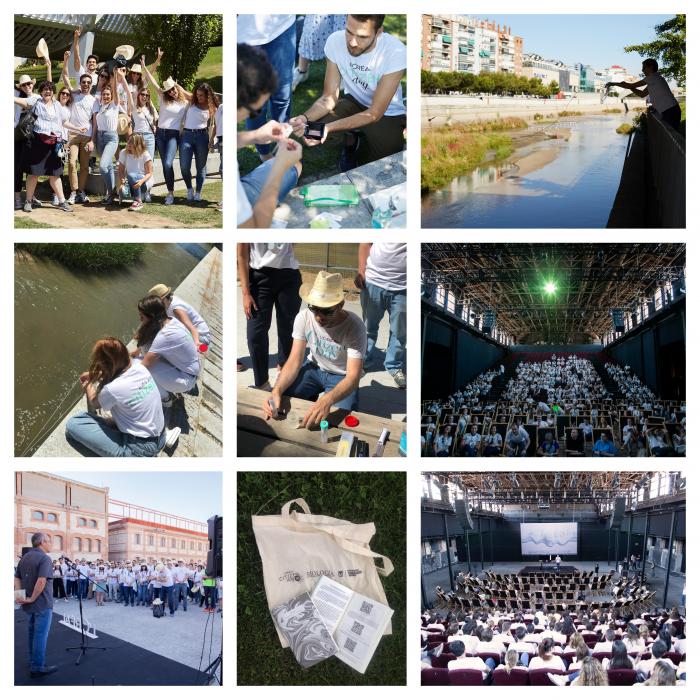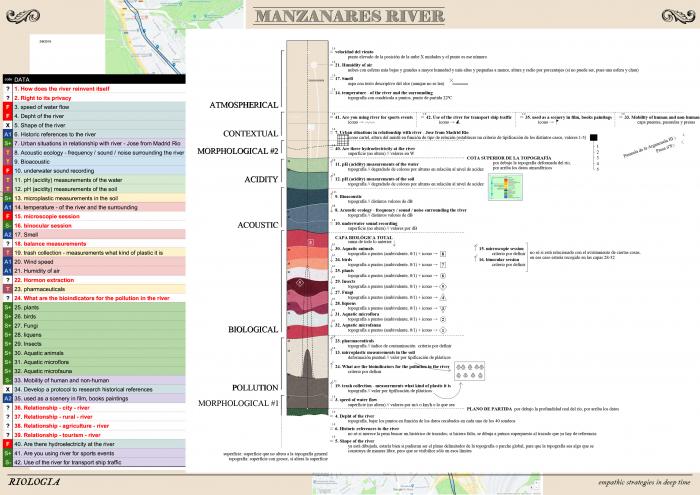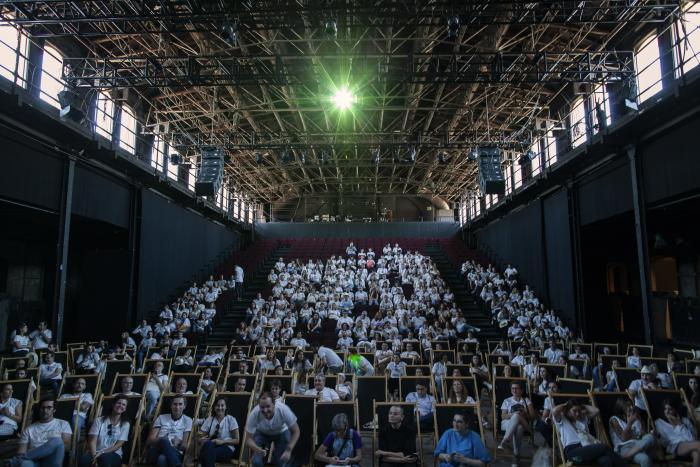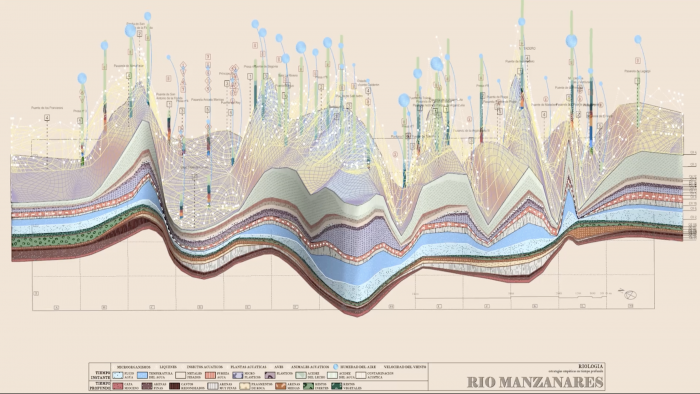I. SUMMARY INFORMATION
Project
269662
Status
Submitted
Award category
Mobilisation of culture, arts and communities
You want to submit
NEW EUROPEAN BAUHAUS AWARDS : existing completed examples
Project title
Riología
Full project title
Riologia | Estrategias empáticas en tiempo profundo _ Empathic Strategies in Deep Time
Description
Riología by the artist Robertina Šebjanič with Instituto Mutante de Narrativas Ambientales de Matadero Madrid is divided into four parts: the citizen science action with 500 volunteers conducting an analysis of the Manzanares River’s ecosystem; the booklet Riología, converts the procedure of scientific-artistic research into a prototype; the artist’s performance visualising the data collected in the river; and the artwork, exploring the river’s memory in deep time.
Where was your project implemented in the EU?
Spain
Madrid
Madrid
Madrid
28530
When was your project implemented?
Has your project benefited from EU programmes or funds?
No
Which programme(s) or fund(s)? Provide the name of the programme(s)/fund(s), the strand/action line as relevant and the year.
II. DESCRIPTION OF THE PROJECT
Please provide a summary of your project
Riología | Empathic strategies of deep time by the artist Robertina Šebjanič with Instituto Mutante de Narrativas Ambientales de Matadero Madrid is a complex project which questions the human relationship with non-human entities through various initiatives and actors. The project is divided into four parts: the citizen science action with 500 volunteers conducting an analysis of the Manzanares River’s ecosystem; the booklet Riología, created for the purposes of the aforementioned analysis and which converts the procedure of scientific-artistic research into a prototype; the artist’s performance visualising the data collected in the river; and the artwork presented here, exploring the river’s memory in deep time.
The idea of the river as “a frontier space” brought forth in the project Riología | Empathic strategies of deep time is embedded in the métier of the Mutant Institute of Environmental Narratives, which views the river as the axis of city transformation, and in the theoretical framework of “post-nature”. The aim of the project is to develop a model for a collective exercise of approaching the Manzanares River, one that will also serve as the basis for similar attempts at approaching other river ecosystems in the future.
Despite humanity’s undisputed relationship with and impact on ecosystems across the planet, when discussing “nature”, we insist on considering humans as not part of it. Since the beginning of the Capitalocene (1450–1750), a historical epoch underscored by commodity production and exchange (Moore, 2017), nature (and with it, sensitivity to whatever was not related to capital accumulation) came to be understood as an entity separate from human society and became an object of exploitation and study. “Nature” or, rather, the “environment” was associated with everything that existed beyond the limitations of human society and culture.
Please give information about the key objectives of your project in terms of sustainability and how these have been met
Empathic strategies
Riología | Empathic strategies of deep time draws on the following question: “How does the river feel us?” Bearing in mind that, at the actual ecological site, it is of utmost importance to re-evaluate humanity’s place on Earth, Robertina Šebjanič launched this project with a view to reversing the anthropocentric logic with empathic strategies.
The action of investigating the river ecosystem, which the artist conceived in collaboration with the team from the Mutant Institute of Environmental Narratives as well as part of the Madrid and international scientific and artistic community aims to develop empathic strategies and analyses.
The booklet Riología, undersigned by several authors, serves as a heterogeneous manual combining different kinds of knowledge and approaches. It presents various meditation practices and strategies to observe the river and in this way encourage a form of connecting with the environment that will help strengthen the respect for and understanding of one of the most delicate natural habitats in the world.
Riología is an interdisciplinary project combining art, science, collective DIY actions, and citizen science. Through art, she develops cognitive questions and offers empathy as a strategy of approaching the river. With science, she uses analytical tools and predictive ecological models. And by applying the DIY principle and citizen science, she promotes empathic strategies, collects data, provides local viewpoints, thus deepening the knowledge about the patterns of change throughout history.
Please give information about the key objectives of your project in terms of aesthetics and quality of experience beyond functionality and how these have been met
Deep time
Whereas Robertina Šebjanič enacts empathic strategies to approach the river with an action of citizen science, her installation exhibited here visualises the deep time of the Manzanares River. The presented columns testify to how the profiles of geological cores or sediment strata accumulated over time. By transforming the geological cores into odours, the artist presents smell as the sense that is most strongly connected with human memory. In this way, she also invites us to readjust our senses and embrace strategies to empathise with non-human entities in order to understand our own relationship towards ecosystems when our generation will be long gone.
Collectively, all of the earth’s rivers contain about 0.0001% of the earth’s water. Although that does not sound like very much, they play a crucial role by constituting one of the main sources of water necessary for the survival of all life forms on the planet. Rivers are dynamic water bodies that are constantly changing, modifying the landscape and their own channels, with changes taking place both in space and time. Drawing on rivers’ capacity to mutate in space and time, Riología | Empathic strategies of deep time refers to long-term processes and the deep time of river ecosystems. In doing so, it builds on the scientific definition of the term “deep time”, which not only alludes to the geological time of an ecosystem, but it also appeals to the need to readjust humanity’s perception of its temporality. On its multiple levels, the project champions the notion of the deep time of our environment and its historical development, as well as the ability to understand beyond the hic et nunc of ecosystems.
Please give information about the key objectives of your project in terms of inclusion and how these have been met
The project focuses on the Manzanares River running through the city of Madrid and the renaturalisation programme with which the city authorities have aimed to return the river to its natural state and enable the restoration of as much biodiversity as possible of both its plant and animal species. Riología is essentially a transdisciplinary project in which the artist combines art, science and DIY principles. It comprises the findings of collective research on the current situation that was conducted within the framework of a one-day workshop, a book of protocols as well as sediment and odour samples. The workshop, conducted using the citizen science approach, was attended by 500 volunteers divided into 40 groups, with each group given a work area at one of the designated points along the selected 8-kilometre stretch of river.
Please give information on the results/impacts achieved by your project in relation to the category you apply for
The results are summarised in an infographic that demonstrates the level of river contamination, biodiversity and the social perception of the river. The aim of the workshop was to observe the environment and collect data and, above all, to develop a strategy for bringing people closer to the environment in the sense of promoting empathy towards vulnerable natural habitats, such as rivers. In other words, it is of crucial importance not to leave all of environmental technical monitoring with state institutions, but rathe to include the public in performing measurements and thus encourage involvement at the individual level.
Please explain the way citizens benefiting from or affected by the project and civil society have been involved in the project and what has been the impact of this involvement on the project
Riología is an interdisciplinary project combining art, science, collective DIY actions, and citizen science. Through art, she develops cognitive questions and offers empathy as a strategy of approaching the river. With science, she uses analytical tools and predictive ecological models. And by applying the DIY principle and citizen science, she promotes empathic strategies, collects data, provides local viewpoints, thus deepening the knowledge about the patterns of change throughout history. The workshop, conducted using the citizen science approach, was attended by 500 volunteers divided into 40 groups, with each group given a work area at one of the designated points along the selected 8-kilometre stretch of river.
Please highlight the innovative character of the project
It is a strong interdisciplinary development between the architects, artist, ecologies, citizen science experts, cultural center and economy with the common goal to work on empathic strategic development of better connection with the river environment and understand it in its rural / urban placement and also true different time with common goal of the view intro the pest to understand the common future.
CREDITS:
Riología | Empathic strategies of deep time
Artist: Robertina Šebjanič
Curator: Amanda Masha Caminals (Instituto Mutante de Narrativas Ambientales de Matadero Madrid – IMNA Matadero Madrid)
Realisation: Instituto Mutante de Narrativas Ambientales de Matadero Madrid and L’Oreal
Project coordination and management: Eduardo Castillo Vinuesa
Visualisation: Paco Alfaro, Sergio del Castillo / MIAU_Infographics
Geological core extraction: Biotopo Consultores
Soil analysis: AGQ Labs
Odour extraction: Ernesto Ventós
Technical support: SceenArt d.o.o.
Editores of the booklet and informe Riologia: Eduardo Castillo Vinuesa, Amanda Masha Caminals, Miranda Moss, Robertina Šebjanič
Special thanks to:
Madrid Ríio (City Council), Rosa Ferré, Plataform-A, Gjino Šutić, Seo BirdLife Madrid,
Ecologistas en acción, Juan Azcarate Luxan, itdUPM, ZAP&BUJ, Mariano Cebrián,
Marko Žavbi, Paloma Jiménez, Sara de Magán, Miranda Moss, Natalia Molina Delgado,
Saša Spačal, Mirjan Švagelj, Maruska Polakova, Miha Godec, Mary Maggic, Kat Austen,
Gjino Šutić, Victoria Vesna, Aleksandar Vejnovic, Sarah Hermanutz, Irene de Andrés, Luis
Ismael Ortega, 500 volunteers of L’Oreal, and especially to the Manzanares River
Please explain how the project led to results or learnings which could be transferred to other interested parties
The methodology of the project Riologia could be applied and modified to other rural and urban environments with adjustment of the workshop methodology to the local situations, with the distributed knowledge system. Where we had broth the 500 ppl to the river without disturbing it, as we had workshop time in 40 smaller groups at the 8 km of the river.
Project resulted as a event for economy - as a team building day and learning about the Citizen science by L’Oréal.
Is an evaluation report or any relevant independent evaluation source available?
III. UPLOAD PICTURES
IV. VALIDATION
By ticking this box, you declare that all the information provided in this form is factually correct, that the proposed project has not been proposed for the Awards more than once under the same category and that it has not been subject to any type of investigation, which could lead to a financial correction because of irregularities or fraud.
Yes





